Sci 225 exam 2 - Study guides, Class notes & Summaries
Looking for the best study guides, study notes and summaries about Sci 225 exam 2? On this page you'll find 65 study documents about Sci 225 exam 2.
All 65 results
Sort by

-
SCI 225 EXAM 2 Questions with Complete Solutions.
- Exam (elaborations) • 10 pages • 2024
- Available in package deal
-
- $10.99
- + learn more
SCI 225 EXAM 2 Questions with Complete Solutions.
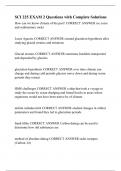
-
SCI 225 EXAM 2 Questions with Complete Solutions
- Exam (elaborations) • 10 pages • 2024
- Available in package deal
-
- $15.99
- + learn more
SCI 225 EXAM 2 Questions with Complete Solutions
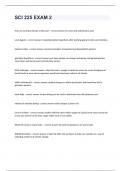
-
SCI 225 EXAM 2 fully solved
- Exam (elaborations) • 7 pages • 2024
- Available in package deal
-
- $12.99
- + learn more
SCI 225 EXAM 2 How can we know climate of the past? - correct answer ice cores and sedimentary rocks Louis Agazzis - correct answer created glaciation hypothesis after studying glacial erratics and striations Glacial erratics - correct answer enormous boulders transported and deposited by glaciers glaciation hypothesis - correct answer over time climate can change and during cold periods glaciers move down and during warm periods they retreat HMS challenger - correct answer a ship t...
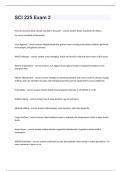
-
SCI 225 Exam 2 questions well answered
- Exam (elaborations) • 6 pages • 2024
- Available in package deal
-
- $12.99
- + learn more
SCI 225 Exam 2 How do we know what climate was like in the past? - correct answer Rocks: hundreds of millions Ice cores: hundreds of thousands Louis Aggassiz - correct answer hypothesized that glaciers were carrying rocks down, evidence gathered from people, and glaciers advance HMS Challenger - correct answer ocean dredging, fossils are found in cold and warm areas of the ocean Theory of Glaciation - correct answer Louis Aggasiz found glacial erratics and glacial striations in the E...
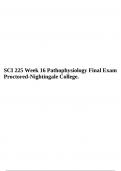
-
SCI 225 Week 16 Pathophysiology Final Exam Proctored-Nightingale College.
- Exam (elaborations) • 26 pages • 2023
-
- $12.99
- 1x sold
- + learn more
SCI 225 Week 16 Pathophysiology Final Exam Proctored-Nightingale College. Question 1 1 / 1 pts A patient with type 1 diabetes asks the nurse what causes polyuria. What is the nurse’s best response? The symptom of polyuria in diabetes mellitus (DM) is caused by: a reduced ADH response caused by insulin deficiency. the loss of protein across the glomerular membrane. the production of ketones. increased glucose in the urine. The presence of glucose in the urine filtrate ...
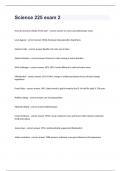
-
SCI 225 EXAM 2 with complete solutions 2024
- Exam (elaborations) • 6 pages • 2024
- Available in package deal
-
- $12.99
- + learn more
SCI 225 EXAM 2How can we know climate of the past? - correct answer ice cores and sedimentary rocks Louis Agazzis - correct answer created glaciation hypothesis after studying glacial erratics and striations Glacial erratics - correct answer enormous boulders transported and deposited by glaciers glaciation hypothesis - correct answer over time climate can change and during cold periods glaciers move down and during warm periods they retreat HMS challenger - correct answer a ship tha...
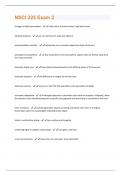
-
NSCI 225 Exam 2 Questions And Answers Graded A+
- Exam (elaborations) • 9 pages • 2024
- Available in package deal
-
- $7.99
- + learn more
3 stages of object perception - early vision, mid-level vision, high-level vision absolute distance - you can tell how far away one object is accommodation and blur - intraocular cue as muscles adjust the shape of the lens atmospheric perspective - due to particles in the atmosphere, objects that are further away look less sharp and clear binocular depth cues - clues about distance based on the differing views of the two eyes binocular disparity - the difference in images for the two eyes ...
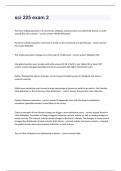
-
sci 225 exam 2 correctly answered
- Exam (elaborations) • 3 pages • 2024
- Available in package deal
-
- $9.99
- + learn more
sci 225 exam 2 The three orbital parameters of eccentricity, obliquity, and precession are collectively known as cycles named after this scientist. - correct answer Milutin Milenkovic Name the orbital parameter movement is similar to the movement of a spinning top. - correct answer Precession (Wobble) This orbital parameter changes on a time scale of 41,000 years - correct answer Obliquity (tilt) Interglacial periods seem to align with what amount of tilt of Earth's axis: higher tilt ...
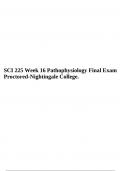
-
SCI 225 Week 16 Pathophysiology Final Exam Proctored-Nightingale College.
- Exam (elaborations) • 26 pages • 2023
- Available in package deal
-
- $12.49
- 1x sold
- + learn more
SCI 225 Week 16 Pathophysiology Final Exam Proctored-Nightingale College. Question 1 1 / 1 pts A patient with type 1 diabetes asks the nurse what causes polyuria. What is the nurse’s best response? The symptom of polyuria in diabetes mellitus (DM) is caused by: a reduced ADH response caused by insulin deficiency. the loss of protein across the glomerular membrane. the production of ketones. increased glucose in the urine. The presence of glucose in the urine filtrat...
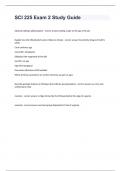
-
SCI 225 Exam 2 Study Guide With answers 2024/2025
- Exam (elaborations) • 1 pages • 2024
- Available in package deal
-
- $9.99
- + learn more
SCI 225 Exam 2 Study GuideAbsolute dating (radioisotopes) - correct answer putting a date on the age of fossils. Explain how the Milankovitch cycles influence climate - correct answer Eccentricity (shape of Earth's orbit) Circle orbit=ice age oval orbit= interglacial Obliquity (the magnitude of the tilt) low tilt= ice age high tilt=interglacial Precession (direction of tilt/wobble) When all three parameters are at their extremes we get ice ages. Describe geologic features in Mic...

How much did you already spend on Stuvia? Imagine there are plenty more of you out there paying for study notes, but this time YOU are the seller. Ka-ching! Discover all about earning on Stuvia


